Design of Ecological CO2 Enrichment System for Greenhouse Production using TBAB + CO2 Semi-Clathrate Hydrate
Abstract
:1. Introduction
2. Theoretical Background
2.1. CO2 Gas Storage Using SC
2.2. Gas Separation Using SC
3. TBAB (+CO2 + N2) SC with Mixed Gas of CO2 + N2
4. Design of CO2 Enrichment System Using SC
4.1. Operation Cycle of System
4.2. Configuration of CO2 Enrichment System Using TBAB + CO2 SC
4.3. Quantitative Evaluation of CO2 Enrichment System Using TBAB + CO2 SC
5. Summary
Acknowledgments
Author Contributions
Conflicts of Interest
References
- Tilman, D.; Cassman, K.G.; Matson, P.A.; Naylor, R.; Polasky, S. Agricultural sustainability and intensive production practices. Nature 2002, 418, 671–677. [Google Scholar] [CrossRef] [PubMed]
- Sethi, V.P.; Sharma, S.K. Survey and evaluation of heating technologies for worldwide agricultural greenhouse applications. Sol. Energy 2008, 82, 832–859. [Google Scholar] [CrossRef]
- Bartzanas, T.; Tchamitchian, M.; Kittas, C. Influence of the heating method on greenhouse microclimate and energy consumption. Biosyst. Eng. 2005, 91, 487–499. [Google Scholar] [CrossRef]
- Tarnawski, V.R.; Leong, W.H.; Momose, T.; Hamada, Y. Analysis of ground source heat pumps with horizontal ground heat exchangers for northern Japan. Renew. Energy 2009, 34, 127–134. [Google Scholar] [CrossRef]
- Woods, J.; Williams, A.; Hughes, J.K.; Black, M.; Murphy, R. Energy and the food system. Phil. Trans. R. Soc. B 2010, 365, 2991–3006. [Google Scholar] [CrossRef] [PubMed]
- Vadiee, A.; Martin, V. Energy management in horticultural applications through the closed greenhouse concept, state of the art. Renew. Sustain. Energy Rev. 2012, 16, 5087–5100. [Google Scholar] [CrossRef]
- Vermeulen, S.J.; Campbell, B.M.; Ingram, J.S.I. Climate change and food systems. Annu. Rev. Environ. Resour. 2012, 37, 195–222. [Google Scholar] [CrossRef]
- Cuce, E.; Harjunowibowo, D.; Cuce, P.M. Renewable and sustainable energy saving strategies for greenhouse systems: A comprehensive review. Renew. Sustain. Energy Rev. 2016, 64, 34–59. [Google Scholar] [CrossRef]
- Peet, M.M.; Willts, D.H. CO2 enrichment of greenhouse tomatoes using a closed-loop heat storage: Effects of cultivar and nitrogen. Sci. Hortic. 1984, 24, 21–32. [Google Scholar] [CrossRef]
- Mortensen, L.M. Review: CO2 enrichment in greenhouses. Crop responses. Sci. Hortic. 1987, 33, 1–25. [Google Scholar] [CrossRef]
- Chalabi, Z.S.; Biro, A.; Bailey, B.J.; Aikman, D.P.; Cockshull, K.E. Optimal control strategies for carbon dioxide enrichment in greenhouse tomato crops—Part 1: Using pure carbon dioxide. Biosyst. Eng. 2002, 81, 421–431. [Google Scholar] [CrossRef]
- Chalabi, Z.S.; Biro, A.; Bailey, B.J.; Aikman, D.P.; Cockshull, K.E. Optimal control strategies for carbon dioxide enrichment in greenhouse tomato crops—Part II: Using the exhaust gases of natural gas fired boilers. Biosyst. Eng. 2002, 81, 323–332. [Google Scholar] [CrossRef]
- Sanchez-Molina, J.A.; Reinoso, J.V.; Acien, F.G.; Rodriguez, F.; Lopez, J.C. Development of a biomass-based system for nocturnal temperature and diurnal CO2 concentration control in greenhouses. Biomass Bioenergy 2014, 67, 60–71. [Google Scholar] [CrossRef]
- Heuvelink, E.; Bakker, M.; Marcelis, L.F.M.; Raaphorst, M. Climate and yield in a closed greenhouse. Acta Hort. 2008, 801, 1083–1092. [Google Scholar] [CrossRef]
- Qian, T.; Dieleman, J.A.; Elings, A.; De Gelder, A.; Marcelis, L.F.M.; Van Kooten, O. Comparison of climate and production in closed, semi-closed and open greenhouses. Acta Hort. 2011, 893, 807–814. [Google Scholar] [CrossRef]
- Yang, S.H.; Lee, C.G.; Ashtiani-Araghi, A.; Kim, J.Y.; Rhee, J.Y. Development and evaluation of combustion-type CO2 enrichment system connected to heat pump for greenhouses. Eng. Agric. Environ. Food 2014, 7, 28–33. [Google Scholar] [CrossRef]
- Nakano, S.; Chang, K.H.; Shijima, A.; Miyamoto, H.; Sato, Y.; Noto, Y.; Ha, J.Y.; Sakamoto, M. A usage of CO2 hydrate: Convenient method to increase CO2 concentration in culturing algae. Bioresour. Technol. 2014, 172, 444–448. [Google Scholar] [CrossRef] [PubMed]
- Umeda, H.; Ahn, D.H.; Iwasaki, Y.; Matsuo, S.; Takeya, S. A cooling and CO2 enrichment system for greenhouse production using CO2 clathrate hydrate. Eng. Agric. Environ. Food 2015, 8, 307–312. [Google Scholar] [CrossRef]
- Sakamoto, M.; Uenishi, M.; Miyamoto, K.; Suzuki, T. Effect of root-zone temperature on the growth and fruit quality of hydroponically grown strawberry plants. J. Agric. Sci. 2016, 8, 1916–9760. [Google Scholar]
- Llorach-Massana, P.; Pena, J.; Rieradevall, J.; Montero, J.I. Analysis of the technical, environmental and economic potential of phase change materials (PCM) for root zone heating in Mediterranean greenhouses. Renew. Energy 2017, 103, 570–581. [Google Scholar] [CrossRef]
- Matsuo, S.; Umeda, H.; Takeya, S.; Fujita, T. A feasibility study on hydrate-based technology for transporting CO2 from industrial to agricultural areas. Energies 2017, 10, 728. [Google Scholar] [CrossRef]
- Zhang, P.; Ma, Z.W.; Wang, R.Z. An overview of phase change material slurries: MPCS and CHS. Renew. Sustain. Energy Rev. 2010, 14, 598–614. [Google Scholar] [CrossRef]
- Castellani, B.; Morini, E.; Filipponi, M.; Nicolini, A.; Palombo, M.; Cotana, F.; Rossi, F. Clathrate hydrates for thermal energy storage in buildings: Overview of proper hydrate-forming compounds. Sustainability 2014, 6, 6815–6829. [Google Scholar] [CrossRef]
- Babu, P.; Linga, P.; Kumar, R.; Englezos, P. A review of the hydrate based gas separation (HBGS) process for carbon dioxide pre-combustion capture. Energy 2015, 85, 261–279. [Google Scholar] [CrossRef]
- Ma, Z.W.; Zhang, P.; Bao, H.S.; Deng, S. Review of fundamental properties of CO2 hydrates and CO2 capture and separation using hydration method. Renew. Sustain. Energy Rev. 2016, 53, 1273–1302. [Google Scholar] [CrossRef]
- Shimada, W.; Shiro, M.; Kondo, H.; Takeya, S.; Oyama, H.; Ebinuma, T.; Narita, H. Tetra-n-butylammonium bromide–water (1/38). Acta Cryst. 2005, 61, o65–o66. [Google Scholar] [CrossRef] [PubMed]
- Rodionova, T.V.; Komarov, V.Y.; Villevald, G.V.; Karpova, T.D.; Kuratieva, N.V.; Manakov, A.Y. Calorimetric and structural studies of tetrabutylammonium bromide ionic clathrate hydrates. J. Phys. Chem. B 2013, 117, 10677–10685. [Google Scholar] [CrossRef] [PubMed]
- Chazallon, B.; Ziskind, M.; Carpentier, Y.; Focsa, C. CO2 capture using semi-clathrates of quaternary ammonium salt: Structure change induced by CO2 and N2 enclathration. J. Phys. Chem. B 2014, 118, 13440–13452. [Google Scholar] [CrossRef] [PubMed]
- Kang, S.P.; Lee, H.; Ryu, B.J. Enthalpies of dissociation of clathrate hydrates of carbon dioxide, nitrogen, (carbon dioxide + nitrogen), and (carbon dioxide + nitrogen + tetrahydrofuran). J. Chem. Thermodyn. 2001, 33, 513–521. [Google Scholar] [CrossRef]
- Delahaye, A.; Fournaison, L.; Marinhas, S.; Chatti, I.; Petitet, J.P.; Dalmazzone, D.; Furst, W. Effect of THF on equilibrium pressure and dissociation enthalpy of CO2 hydrates applied to secondary refrigeration. Ind. Eng. Chem. Res. 2006, 45, 391–397. [Google Scholar] [CrossRef]
- Lee, Y.; Lee, D.; Lee, J.W.; Seo, Y. Enclathration of CO2 as a co-guest of structure H hydrates and its implications for CO2 capture and sequestration. Appl. Eng. 2016, 163, 51–59. [Google Scholar] [CrossRef]
- Lin, W.; Delahaye, A.; Fournaison, L. Phase equilibrium and dissociation enthalpy for semi-clathrate hydrate of CO2 +TBAB. Fluid Phase Equilib. 2008, 264, 220–227. [Google Scholar] [CrossRef]
- Udachin, K.A.; Ratcliffe, C.I.; Ripmeester, J.A. Structure, composition, and thermal expansion of CO2 hydrate from single crystal X-ray diffraction measurements. J. Phys. Chem. B 2001, 105, 4200–4204. [Google Scholar] [CrossRef]
- Moudrakovski, I.L.; Udachin, K.A.; Alavi, S.; Ratcliffe, C.I.; Ripmeester, J.A. Facilitating guest transport in clathrate hydrates by tuning guest-host interactions. J. Chem. Phys. 2015, 142, 074705. [Google Scholar] [CrossRef] [PubMed]
- Tezuka, K.; Shen, R.; Watanabe, T.; Takeya, S.; Alavi, S.; Ripmeester, J.A.; Ohmura, R. Synthesis and characterization of a structure H hydrate formed with carbon dioxide and 3,3-dimethyl-2-butanone. Chem. Commun. 2013, 49, 505–507. [Google Scholar] [CrossRef] [PubMed]
- Kamata, Y.; Oyama, H.; Shimada, W.; Ebinuma, T.; Takeya, S.; Uchida, T.; Nagao, J.; Narita, H. Gas separation method using tetra-n-butyl ammonium bromide semi-clathrate hydrate. Jpn. J. Appl. Phys. 2004, 43, 362–365. [Google Scholar] [CrossRef]
- Lee, S.; Park, S.; Lee, Y.; Lee, J.; Lee, H.; Seo, Y. Guest gas enclathration in semiclathrates of tetra-n-butylammonium bromide: Stability condition and spectroscopic analysis. Langmuir 2011, 27, 10597–10603. [Google Scholar] [CrossRef] [PubMed]
- Muromachi, S.; Udachin, K.A.; Shin, K.; Alavi, S.; Moudrakovski, I.L.; Ohmura, R.; Ripmeester, J.A. Guest-induced symmetry lowering of an ionic clathrate material for carbon capture. Chem. Commun. 2014, 50, 11476–11479. [Google Scholar] [CrossRef] [PubMed]
- Muromachi, S.; Hashimoto, H.; Maekawa, T.; Takeya, S.; Yamamoto, Y. Phase equilibrium and characterization of ionic clathrate hydrates formed with tetra-n-butylammonium bromide and nitrogen gas. Fluid Phase Equilib. 2016, 413, 249–253. [Google Scholar] [CrossRef]
- Muromachi, S.; Udachin, K.A.; Alavi, S.; Ohmura, R.; Ripmeester, J.A. Selective occupancy of methane by cage symmetry in TBAB ionic clathrate hydrate. Chem. Commun. 2016, 52, 5621–5624. [Google Scholar] [CrossRef] [PubMed]
- Duc, N.H.; Chauvy, F.; Herri, J.M. CO2 capture by hydrate crystallization—A potential solution for gas emission of steelmaking industry. Energy Convers. Manag. 2007, 48, 1313–1322. [Google Scholar] [CrossRef]
- Adisasmito, S.; Frank, R.J., III; Sloan, E.D. Hydrates of carbon dioxide and methane mixtures. J. Chem. Eng. Data 1991, 36, 68–71. [Google Scholar] [CrossRef]
- Lee, Y.; Lee, S.; Lee, J.; Seo, Y. Structure identification and dissociation enthalpy measurements of the CO2 + N2 hydrates for their application to CO2 capture and storage. Chem. Eng. J. 2014, 246, 20–26. [Google Scholar] [CrossRef]
- Jhaveri, J.; Robinson, D.B. Hydrates in the methane-nitrogen system. Can. J. Chem. Eng. 1965, 43, 75–78. [Google Scholar] [CrossRef]
- Ye, N.; Zhang, P. Equilibrium data and morphology of tetra-n-butyl ammonium bromide semiclathrate hydrate with carbon dioxide. J. Chem. Eng. Data 2012, 57, 1557–1562. [Google Scholar] [CrossRef]
- Mohammadi, A.H.; Eslamimanesh, A.; Belandria, V.; Richon, D. Phase equilibria of semiclathrate hydrates of CO2, N2, CH4, or H2 + tetra-n-butylammonium bromide aqueous solution. J. Chem. Eng. Data 2011, 56, 3855–3865. [Google Scholar] [CrossRef]
- Mohammadi, A.H.; Eslamimanesh, A.; Belandria, V.; Richon, D.; Naidoo, P.; Ramjugernath, D. Phase equilibrium measurements for semi-clathrate hydrates of the (CO2 + N2 + tetra-n-butylammonium bromide) aqueous solution system. J. Chem. Thermodyn. 2012, 46, 57–61. [Google Scholar] [CrossRef]
- Deschamps, J.; Dalmazzone, D. Dissociation enthalpies and phase equilibrium for TBAB semi-clathrate hydrates of N2, CO2, N2 + CO2 and CH4 + CO2. J. Therm. Anal. Calorim. 2009, 98, 113–118. [Google Scholar] [CrossRef]
- Hashimoto, H.; Yamaguchi, T.; Kinoshita, T.; Muromachi, S. Gas separation of flue gas by tetra-n-butylammonium bromide hydrates under moderate pressure conditions. Energy 2017, 129, 292–298. [Google Scholar] [CrossRef]
- Muromachi, S.; Takeya, S.; Yamamoto, Y.; Ohmura, R. Characterization of tetra-n-butylphosphonium bromide semiclathrate hydrate by crystal structure analysis. CrystEngComm 2014, 16, 2056–2060. [Google Scholar] [CrossRef]
- Muromachi, S.; Yamamoto, Y.; Takeya, S. Bulk phase behavior of tetra-n-butylammonium bromide hydrates formed with carbon dioxide or methane gas. Korean J. Chem. Eng. 2016, 33, 1917–1921. [Google Scholar] [CrossRef]
- Sayaria, A.; Belmabkhouta, A.; Serna-Guerrero, R. Flue gas treatment via CO2 adsorption. Chem. Eng. J. 2011, 171, 760–774. [Google Scholar] [CrossRef]
- Kumano, H.; Hirata, T.; Mitsuishi, K.; Ueno, K. Experimental study on effect of electric field on hydrate nucleation in supercooled tetra-n-butyl ammonium bromide aqueous solution. Int. J. Refrig. 2012, 35, 1266–1274. [Google Scholar] [CrossRef]
- Brinchi, L.; Castellani, B.; Rossi, F.; Cotana, F.; Morini, E.; Nicolini, A.; Filipponi, M. Experimental investigations on scaled-up methane hydrate production with surfactant promotion: Energy considerations. J. Petrol. Sci. Eng. 2014, 120, 187–193. [Google Scholar]
- Mori, Y.H. Thermal resistances in stirred-tank and tubular reactors for clathrate-hydrate formation: Estimating their reactor-scale dependences. Chem. Eng. Res. Des. 2017, 117, 715–724. [Google Scholar] [CrossRef]
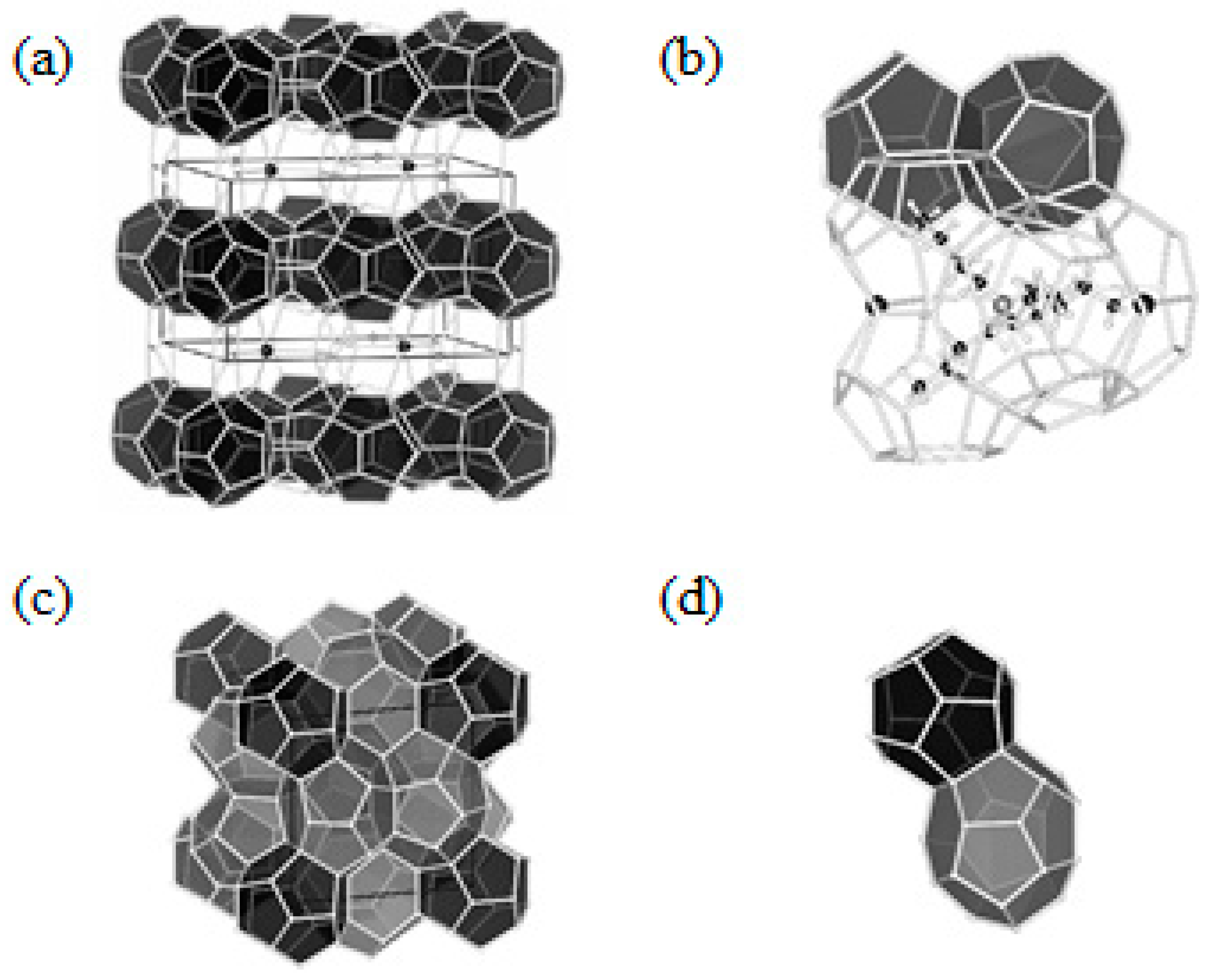
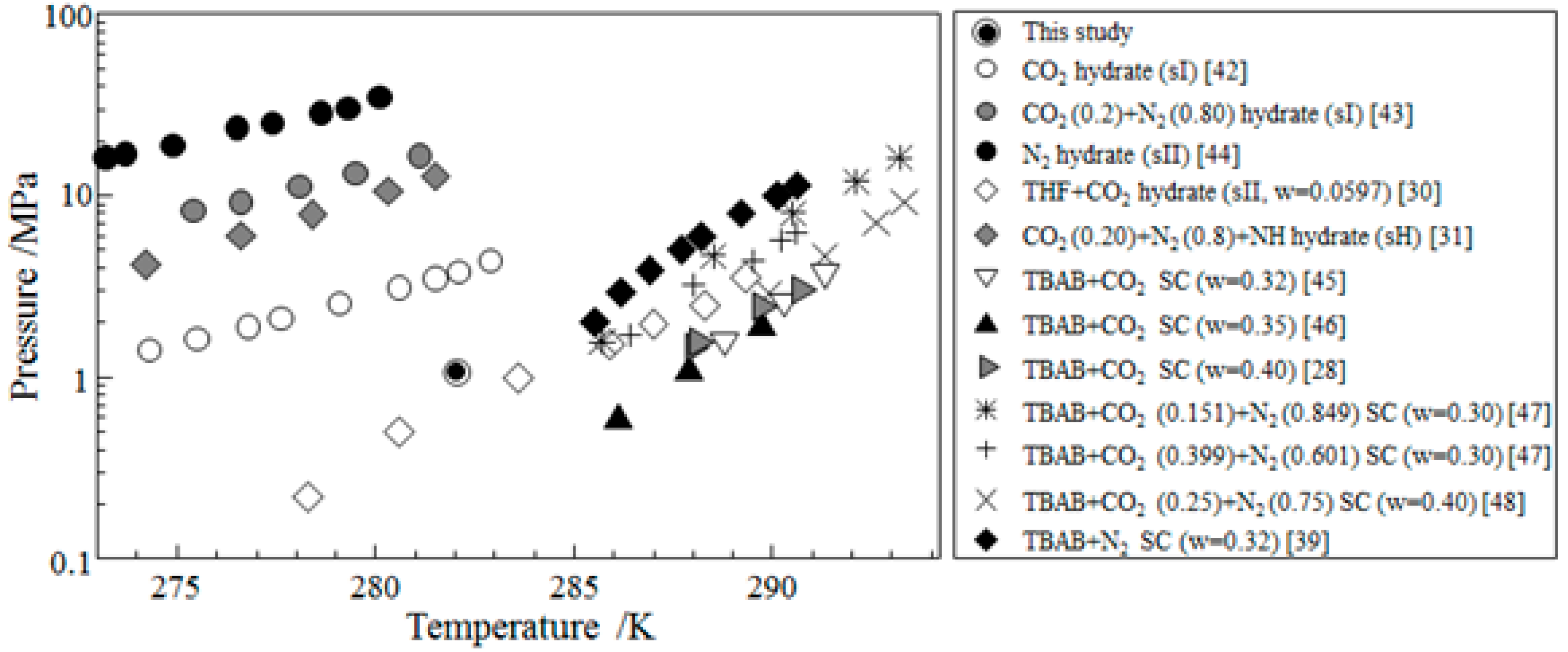
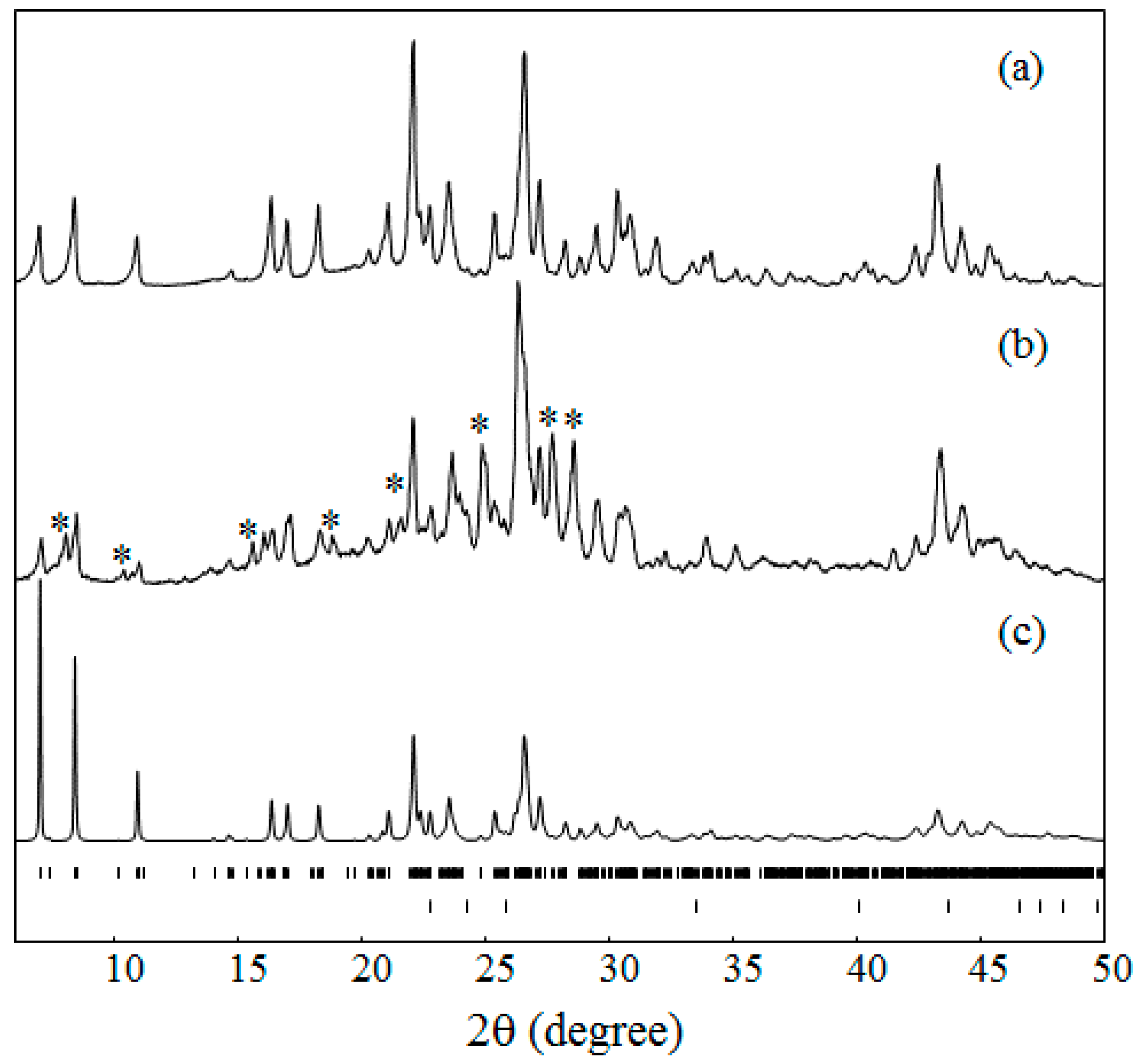
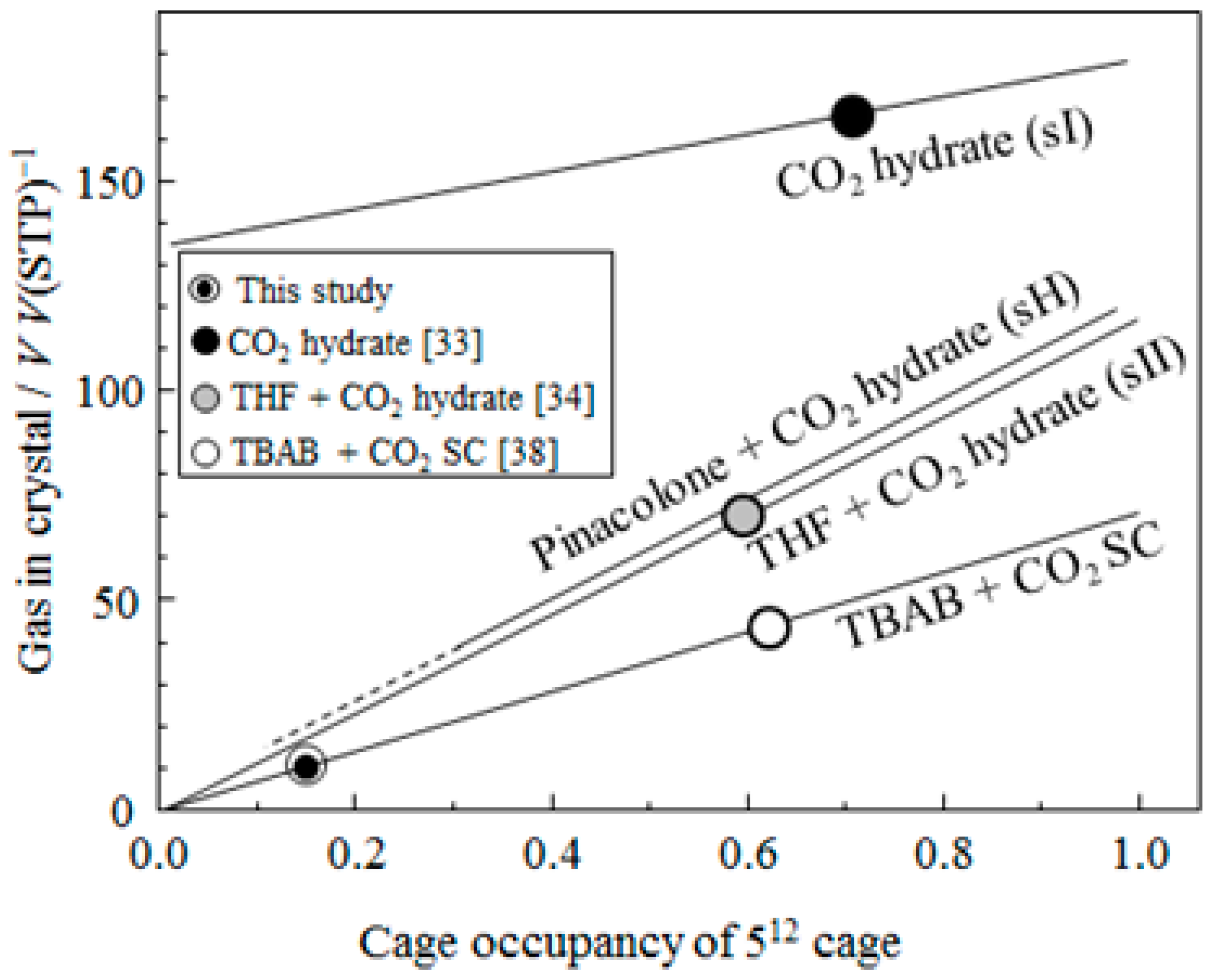
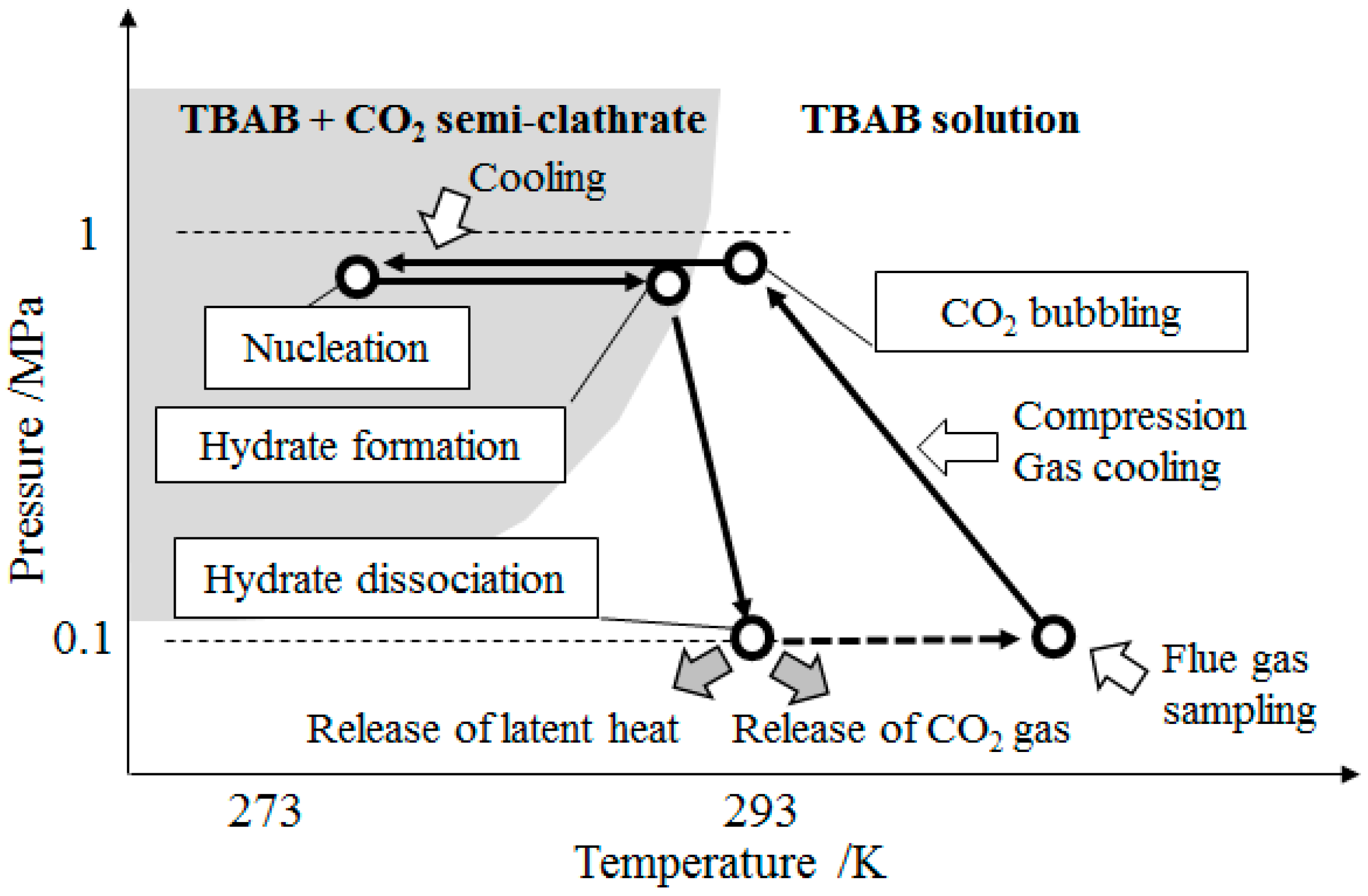
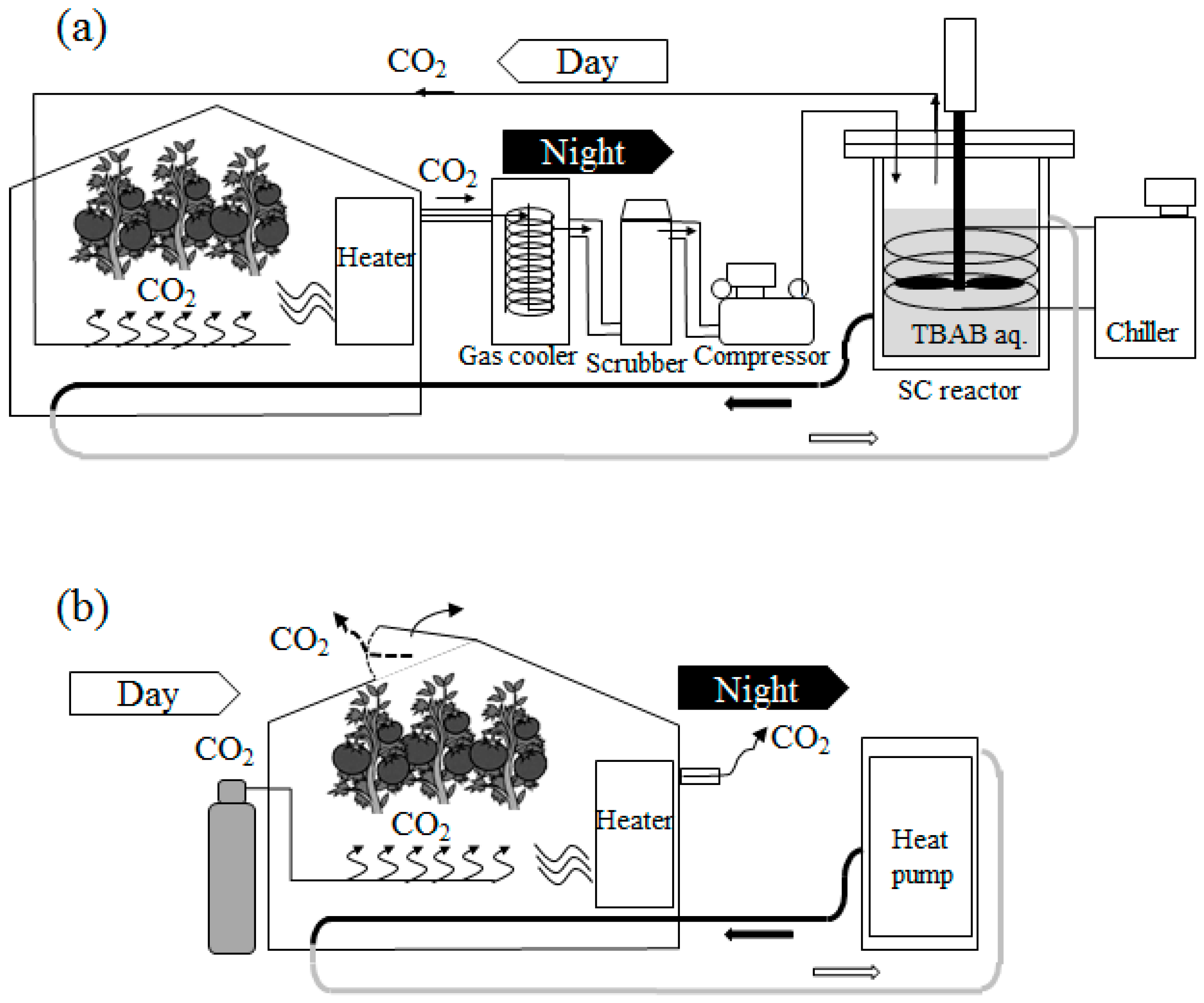
| Structure | Space Group | Hydration Number | Lattice Constant/Å | Cage Type Number of Cages | Promoter | ∆H/kJ mol−1 |
|---|---|---|---|---|---|---|
| sI | Cubic | 46 | a ≈ 12 | 512/51262 | Non | 65 [29] |
| Pm3n | 2/6 | |||||
| sII | Cubic | 136 | a ≈ 17 | 512/51264 | THF | 142 [30] |
| Fd-3m | 16/8 | |||||
| sH * | Hexagonal | 34 | a ≈ 12 | 512/435663/51268 | NH | 61 [31] |
| P6/mmm | c ≈ 10 | 3/2/1 | ||||
| SC | Orthorhombic | 76 | a ≈ 21 | 512/51262/51263 | TBAB | 140 [32] |
| b ≈ 13 | ||||||
| Pmma | c ≈ 12 | 6/4/4 |
© 2017 by the authors. Licensee MDPI, Basel, Switzerland. This article is an open access article distributed under the terms and conditions of the Creative Commons Attribution (CC BY) license (http://creativecommons.org/licenses/by/4.0/).
Share and Cite
Takeya, S.; Muromachi, S.; Maekawa, T.; Yamamoto, Y.; Mimachi, H.; Kinoshita, T.; Murayama, T.; Umeda, H.; Ahn, D.-H.; Iwasaki, Y.; et al. Design of Ecological CO2 Enrichment System for Greenhouse Production using TBAB + CO2 Semi-Clathrate Hydrate. Energies 2017, 10, 927. https://doi.org/10.3390/en10070927
Takeya S, Muromachi S, Maekawa T, Yamamoto Y, Mimachi H, Kinoshita T, Murayama T, Umeda H, Ahn D-H, Iwasaki Y, et al. Design of Ecological CO2 Enrichment System for Greenhouse Production using TBAB + CO2 Semi-Clathrate Hydrate. Energies. 2017; 10(7):927. https://doi.org/10.3390/en10070927
Chicago/Turabian StyleTakeya, Satoshi, Sanehiro Muromachi, Tatsuo Maekawa, Yoshitaka Yamamoto, Hiroko Mimachi, Takahiro Kinoshita, Tetsuro Murayama, Hiroki Umeda, Dong-Hyuk Ahn, Yasunaga Iwasaki, and et al. 2017. "Design of Ecological CO2 Enrichment System for Greenhouse Production using TBAB + CO2 Semi-Clathrate Hydrate" Energies 10, no. 7: 927. https://doi.org/10.3390/en10070927
APA StyleTakeya, S., Muromachi, S., Maekawa, T., Yamamoto, Y., Mimachi, H., Kinoshita, T., Murayama, T., Umeda, H., Ahn, D.-H., Iwasaki, Y., Hashimoto, H., Yamaguchi, T., Okaya, K., & Matsuo, S. (2017). Design of Ecological CO2 Enrichment System for Greenhouse Production using TBAB + CO2 Semi-Clathrate Hydrate. Energies, 10(7), 927. https://doi.org/10.3390/en10070927






